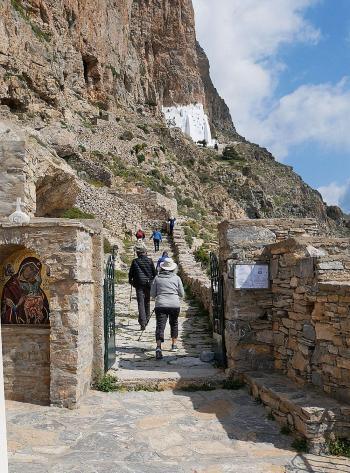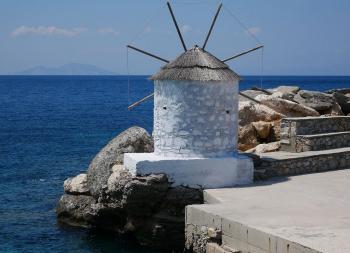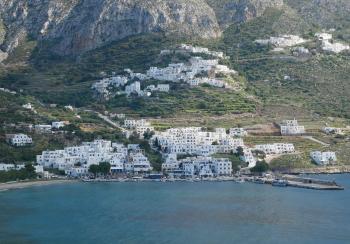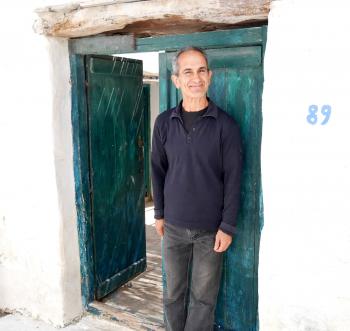Walking the ‘blue paths’ of Greece’s Cyclades
This article appears on page 6 of the September 2019 issue.
In the Cyclades, a group of Greek islands in the Aegean Sea, trails are called “blue paths.” With every turn, you can expect a view of the sea. How prescient of our group of 11 walkers to have signed up to explore paths on three of these islands with an organization called The Blue Walk!
Headquartered in Orlando, Florida, The Blue Walk (phone, in the US, 551/258-3955, www.thebluewalk.com) offers small-group walking vacations in Italy, Spain and France as well as the Cyclades. Its tag line, “Travel at the speed of you,” sounded irresistible to one of my weekly walking buddies, who asked if I would also be interested. Word of mouth added others to our prospective group until we had a number sufficient to ask The Blue Walk if they might tweak their itinerary for us, crossing off Santorini, well known to most of our group, to substitute a less-loved-to-death island. Done!
Paros would become the first island visited on our mid-April 2019 tour, then we would continue to Amorgos and Naxos as scheduled.
First impressions
We gathered in Athens — two married couples, one mother-and-grown-son combo and the balance, solo women — to overnight at the centrally located Electra Hotel, a boutique hotel located on pedestrian-only Ermou Street. Heading up to the hotel’s top-floor restaurant, I stepped out of the elevator to an astonishing, straight-on view of the Parthenon. Welcome to Greece!
Wake-up calls had us ready to leave by taxi at 6:30 the next morning for the Athens port of Piraeus. There we boarded a Blue Star ferry for the 4-plus-hour sail to Parikia, Paros’ capital and main port, where our Blue Walk adventure would officially begin.
Blue Star Ferries are multistoried affairs with escalators delivering passengers to seating areas with rows of comfortable seats, in addition to restaurants, lounges and outside decks. Organized chaos described the simultaneous loading and unloading of cars, trucks and passengers, making me wonder if the bag I’d pushed onto a shelf in a lower-deck holding area would ever be seen again.
Suzy Schutz, who owns The Blue Walk with co-owner Jeannette Candau, awaited our arrival at the dock. Suzy would be our primary guide throughout the itinerary.
A pickup truck would deliver our bags to the Sunset View Hotel (where we’d headquarter our 3-night Paros stay) while we walked at the speed of Suzy, setting off on a seaside path to lunch at one of the fish tavernas that lined Parikia’s waterfront. Most had not yet opened for the season, their owners slathering new whitewash on exteriors and freshening doors and window trim with blue paint to prepare for the influx of visitors who would begin to arrive after Easter, just two weeks away.
Seated at a long table on the terrace of Ouzeri Apostolis, we were introduced to Cycladic cuisine. Tzatziki, yogurt mixed with diced cucumber and laced with dill, garlic and lemon, was served alongside a basket of bread — a mealtime regular, we would discover. Platters of food soon arrived to be shared, family style. The standout, an assortment of grilled seafood, was so fresh that it had undoubtedly been pulled from the Aegean that very morning, courtesy of the colorful fishing boats bobbing in Parikia’s harbor.
En route to our hotel, Suzy took us on a walking tour of Parikia that made it difficult to imagine that at the apex of high season, Paros is jam-packed with visitors. As the easier-to-get-to-by-ferry and less-expensive Cyclades island, Paros is challenging Mykonos as a “party” getaway. To us, Paros presented an idyllic whitewashed, blue-domed panorama framed by the ever-changing shades of blue from the sea. All was enhanced during our springtime visit by fields of wildflowers burst into bloom thanks to a rainy winter that had followed 10 years of drought.
Exploring Paros
The family-owned Sunset View Hotel, perched on a hillside overlooking Parikia, necessitated a bit of huff-and-puff when walking up to it, though it was an easy jaunt when returning to town. As its name suggested, sunset views were a given.
Rooms were connected via archways, stairways and open-to-the-sky corridors; a saltwater pool floated off to the horizon, and restaurant seating offered a choice of indoor or terrace dining.
All of The Blue Walk’s itineraries promise a touch of luxury. On our tour, that translated not only to hotels but also to a leisurely start to the day, usually around 10 o’clock.
Mornings were devoted to scheduled walks. On Paros, all but one were “blue paths,” and that one, despite our not seeing the sea at every turn, remained among our most unforgettable.
A public bus delivered us to Lefkés, considered one of the island’s most lovely villages, where we were met under a misty sky by Christoforos Korovesis, founder of Paros Hikes.
Located in the mountains of central Paros and surrounded by pine and olive trees, Lefkés was Paros’ capital at a time when pirates sailed the seas and it was important that villages be as invisible as possible to marauders’ eyes. Lefkés stone buildings disappeared into the rocky terrain; many, even today, remain untouched by the whitewash that has come to define the buildings of the Cyclades.
We paid a visit to the Byzantine church of Agia Triada that overlooked the village. Matching bell towers constructed from the famed white marble once extensively quarried on the island reached toward the sky.
With mist turning to drizzle, Chris led us to the nearby Byzantine Way, a centuries-old trail paved with marble between Lefkés and the neighboring village of Prodromos. Wildflowers and herbs were in breathtaking bloom on either side of the path, and Chris, well versed in botany, stopped to describe the botanical and common names of plants along with their traditional medicinal usages.
We also learned that “marble paved” did not translate to a gleaming white sidewalk. Instead, we found ourselves picking our way over chunks of marble haphazardly strewn and not smoothly worn.
As drizzle turned to serious rain, those with walking sticks steadied themselves on the now-slippery chunks. Thunderclaps and lightning announced what was coming next: hail! Somehow we carried on, arriving in Prodromos ready for lunch and thankful of no need to call on Chris’ expertise as a certified first-aid provider.
Along the harbor
Our next days’ walks offered easy going along seaside paths under sunny skies. On the first, we followed a deep-cut bay on the northern end of the island to Naoussa, which, while it can no longer be called a quaint fishing village, remains a town of traditional charm.
A labyrinth of streets lined with whitewashed buildings, now home to upscale shops, took us to the old fishing harbor. Choosing Taverna Glafkos as our lunch spot, one of many cafés and restaurants along the harbor’s edge, we enjoyed an elegantly prepared, multicourse lunch that, with wine, added up to less than the equivalent of $10 each.
Our last Paros walk was closer to home, following a back-and-forth path out of Parikia that featured wildflowers galore and an opportunity to observe the sea in its to-the-bottom clarity and many hues of blue.
Afternoons throughout our itinerary were left free to do as one wished. In Parikia, after asking several passersby where it might be, I found the massive Panagia Ekatontapiliani, known as the Church of 100 Doors, located a bit inland from the harbor. This 4th-century church was built on the site of an ancient temple of Artemis, goddess of hunting, wild animals and wilderness, and two of the temple’s columns can be seen inside the main building.
Steps away from the church was Parikia’s archaeology museum, with hundreds of findings from excavations on the island on display — vessels, pottery, jewelry, relics, architectural remnants and more, dating from Neolithic to Roman times.
As I viewed the artifacts, a visit to the nearby islet of Delos several years before came to mind. Then, I’d asked my guide, “When was it that myth ended and history began?” He responded, “This is Greece. It hasn’t.”
It was a thought to ponder on our days in the Cyclades.
On to Amorgos
We’d been primed for long ferry rides at inconvenient hours in advance of our trip, especially for our Paros-to-Amorgos transfer, with departure at 10 p.m. and arrival 1:10 a.m.
After gathering our bags and making certain that everyone was on the bus that was waiting for us at the dock, it was nearing 2 a.m. when we pulled in at the Aegialis Hotel & Spa. However, we received a reception as gracious as if it had been 2 in the afternoon.
A full staff sped us through check-in, and squares of chocolate cake accompanied shot glasses of psimeni raki, the local firewater tamed with the addition of cinnamon and honey. I was certainly ready to be led to the room that would be mine for the next four nights.
From my balcony, I could look across the bay to the waterfront town of Aegiali and could hear the soft slap of the sea against the shore below.
The Giannakopoulos family, generational Amorgans and owners of the hotel, were the first to offer rooms for rent, the rate in 1965 equivalent to $5 night. “We got the feel for the potential of tourism early on,” Irene, the family matriarch, told me.
At that time, Amorgos had no roads, only donkey trails, the main road not completed until 1988. It was then that Irene and her husband, Nikitas, looked at the hillside overlooking the bay and thought it would make a fine location for a hotel. In 1991, it opened.
Today, the 50-room hotel stretches over the hillside on multiple levels, with stairs and arches replicating the style of the traditional Cyclades. Ten years ago, son Stamatis, now general manager, suggested a spa as a means of extending the tourism season; the Lalon Idor’s menu currently lists a full array of treatments in a building dedicated to well-being and body care. In more recent years, two yoga studios were added.
Hiking with Hanna
Accompanied by guide Hanna Moik, a longtime resident of Amorgos with tales to tell, we shuttled into the mountainous middle of the island. At an overlook, we paused for a photo view of Chora, the island’s tucked-into-the-mountains capital with a series of five landmark windmills standing on a nearby ridge, but exploration of Chora would come later. We had steps to climb!
Three hundred steps, Hanna told us, with Suzy reassuringly adding that they were “donkey steps,” every three or four interspersed with a flat space. The steps wound up the side of a cliff to the monastery Panagia Hozoviotissa. Wedged into the cliff face 1,000 feet above the sea, the 8-story-high (but only 10-foot-deep) structure resembled a narrow chest of drawers. So it has been since 1088.
Inside, the stairs between levels grew increasingly steep and narrow, the final level opening into a stark room furnished only with a wooden table.
In the 18th century, 100 monks lived at Hozoviotissa; now there are only four. One of the four, casually dressed but with a manner as stern as that of the past abbotts whose portraits lined the walls, placed a complimentary plate of what elsewhere is known as the confection Turkish delight on the table along with shot glasses of psimeni raki.
As we stood at the top, looking far, far down into twin bays, the molten-blue water was of such clarity that rocks and sand ripples were visible in the seabed.
Returning to Chora, Hanna walked us through the town, pointing out the first high school founded in Greece following the War of Independence, which began in 1821; the remains of a 13th-century Venetian fortress on a rocky outpost; the island’s archaeological museum, still closed for the season, housed in the main hall of a restored Venetian tower; dozens of Byzantine and early Christian churches, the smallest with room for just three, and the island’s only post office, gymnasium and police department (which consists of one car and one policeman).
Following a labyrinth of cobbled streets, we passed through the tree-shaded upper square and walked down to the lower square, with members of our group peeling off along the way as they chose lunchtime spots.
In the lower square I spotted a kafe neio, part grocery store, part café, part men’s social center. While fast disappearing in Greece, every village on Amorgos still has one.
Not too long ago, women were not welcome in kafeneios, and in the smallest villages that remains so, but most have now become small-scale restaurants offering menus of dishes prepared in still-teeny kitchens.
At Kafeneio Parvas, five of us shared a family-style meal of tiny fava beans and boiled potatoes simmered in a light tomato sauce made for bread dipping plus a platter of sliced baby beets presented with their greens sautéed in olive oil and amplified with a squeeze of lemon.
A free afternoon out
We had been on several morning walks in the northern section of seahorse-shaped Amorgos, with the one notable excursion to Chora taking us into its middle, but that left its southwest “tail” unexplored.
There, the majority of the island’s ancient sites could be found. Among the oldest archaeological treasures are Cycladic figures, dating to 2700 BC.
Studying a map, four of us chose Ancient Arkesini as a site to visit on one of our free afternoons. Inhabited since prehistoric times and situated on a dramatic rocky site overlooking the sea, it was accessible by one of the island’s marked footpaths.
In Aegiali, we arranged with the island’s sole taxi driver (later in the season there would be four) round-trip transportation to the settlement of Vroutsi, where we could pick up the trail. Unfortunately, midway in our walk to Ancient Arkesini, we were buffeted by winds of such ferocity that it became dangerous to continue.
The Greek Isles are known for their legendary meltemi, May-through-September afternoon winds of such gale force that they can wreak havoc on ferries. But this was April!
The wind became less fearsome as we returned through a landscape of farmed terraces lush with springtime grains on a wildflower-bordered path that eventually took us into modern-day Arkesini and that evening’s dinner stop, Taverna Marouso. Our driver, who was already there visiting with friends at a table in a far corner, indicated that we didn’t need to hurry.
Seated on the covered terrace, we began with a bowl of pureed lentils topped with sliced red onion and sprinkled with capers to spread on bread. Plump grilled sardines came next, followed by patatato, an Amorgos signature dish of goat and potatoes slow stewed with onion and herbs, all washed down with a carafe of local wine. The meal ended with a surprise of a complimentary dessert of poached pears and squares of moist, lemony cake.
The total cost for our afternoon excursion was the euro equivalent of about $30 each.
Next up, Naxos
A 6:20 a.m. ferry departure the next morning took us past what may be one of the Cyclades’ most astounding sights, an enormous marble doorway leading to nowhere that guards Naxos Town’s harbor. Known as the Portara, it stands on what was once a hill but is now a small island connected by a causeway to the town.
Naxos Town came as a shock after the idyllic serenity of the towns of Paros and Amorgos. Noisy cars and motorcycles whizzed by us on paved streets as Suzy led us on a walking tour, but beyond the honky-tonk of the restaurant-lined waterfront and busy downtown, the Old Quarter offered a familiar mix of cobbled alleys, archways and old houses. At its center was a castle, built by Venetian Emperor Markos Sanoudos in 1207, which served as the Cyclades seat of power for 300 years.
Unlike our hotels on Paros and Amorgos, the Naxos Resort was located but a few minutes’ stroll from both the beach and the downtown shopping area with its array of opportunities to browse or buy, delighting the shoppers among us.
By public bus, we traveled inland into the lush Tragea Valley the next morning to visit Chalki, once a thriving commercial hub. The neoclassical mansions and paved squares that speak to its past prosperity have been turned into art and craft galleries, specialty boutiques, restaurants and cafés, and the town is now a mecca for visitors.
A path out of Chalki took us through age-old olive groves, terraced vineyards and abundant vegetable gardens, passing tucked-away Byzantine churches, a watermill and a donkey that might have once walked this trail when it was the main road to the neighboring village of Moni.
That evening we said farewell to the Cyclades as we’d said hello, gathered around a table at a fish taverna at the edge of the sea.
A few details
Our tweaked 12-night trip with The Blue Walk cost $2,895 per person, double occupancy. Included in the price were daily breakfasts; some lunches; welcome and farewell dinners; daily guided walks; ferries between islands and return to Athens, and a one-night Athens hotel stay before our flight home.
The Blue Walk’s 2020 12-night Greek Isles trip (including Santorini instead of Paros) is priced from $2,995 per person.
At number 89 on a street of steps in the village of Langada, Vangelis Vassalos, trained both in pharmacy and oriental medicine, welcomed us to his laboratory, where he described the process of drying and distilling the springtime gatherings of aromatic herbs that grow in profusion on Amorgos. The process results in essential essences used in products he and his wife, Elani, offer for sale at their shop. The shop, located down more steps and curves from the distillery, was filled to the brim with products ranging from soap to tinctures for whatever ails you.

_Moment-itok=Ha7nRjPq.jpg)



